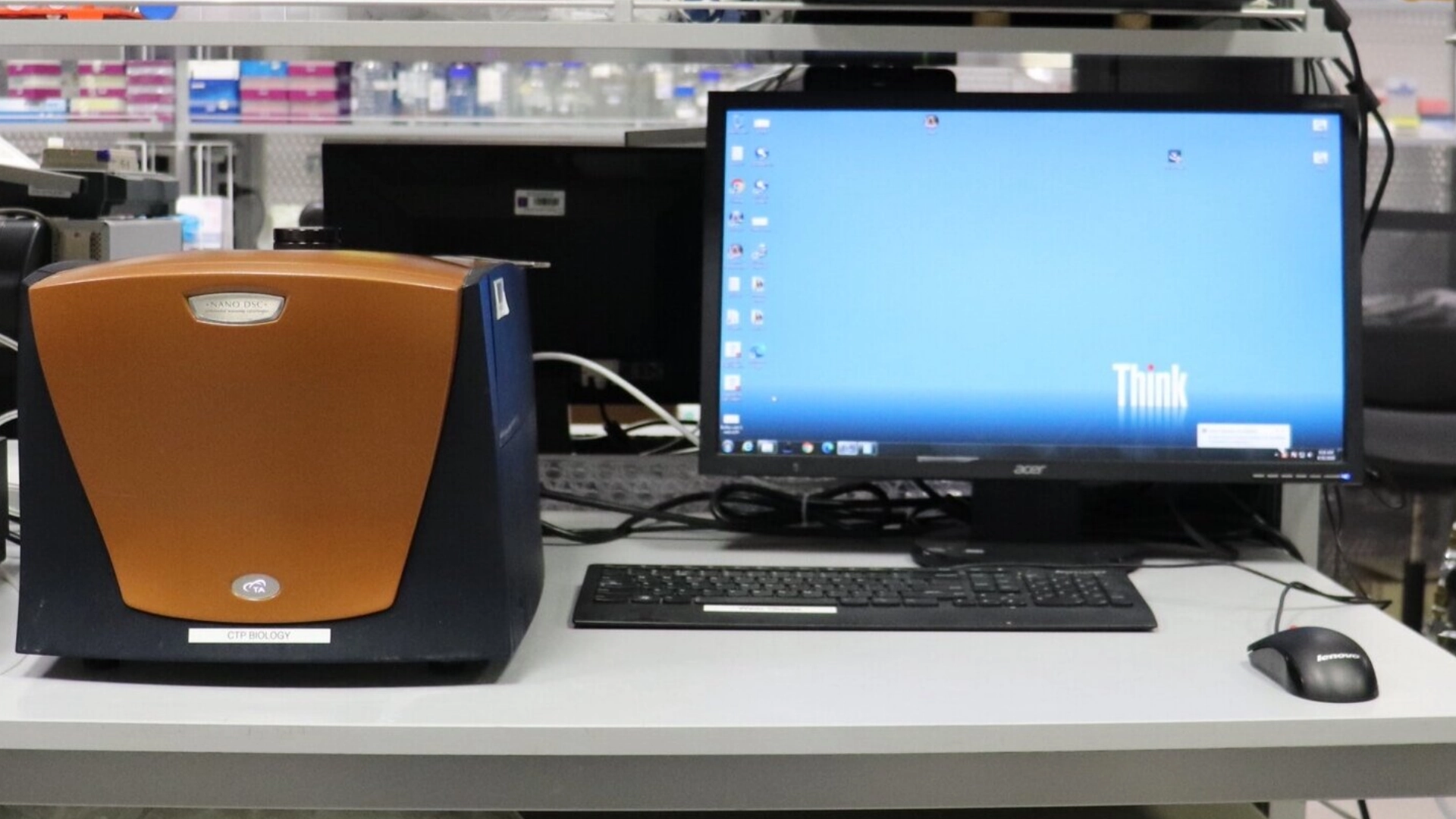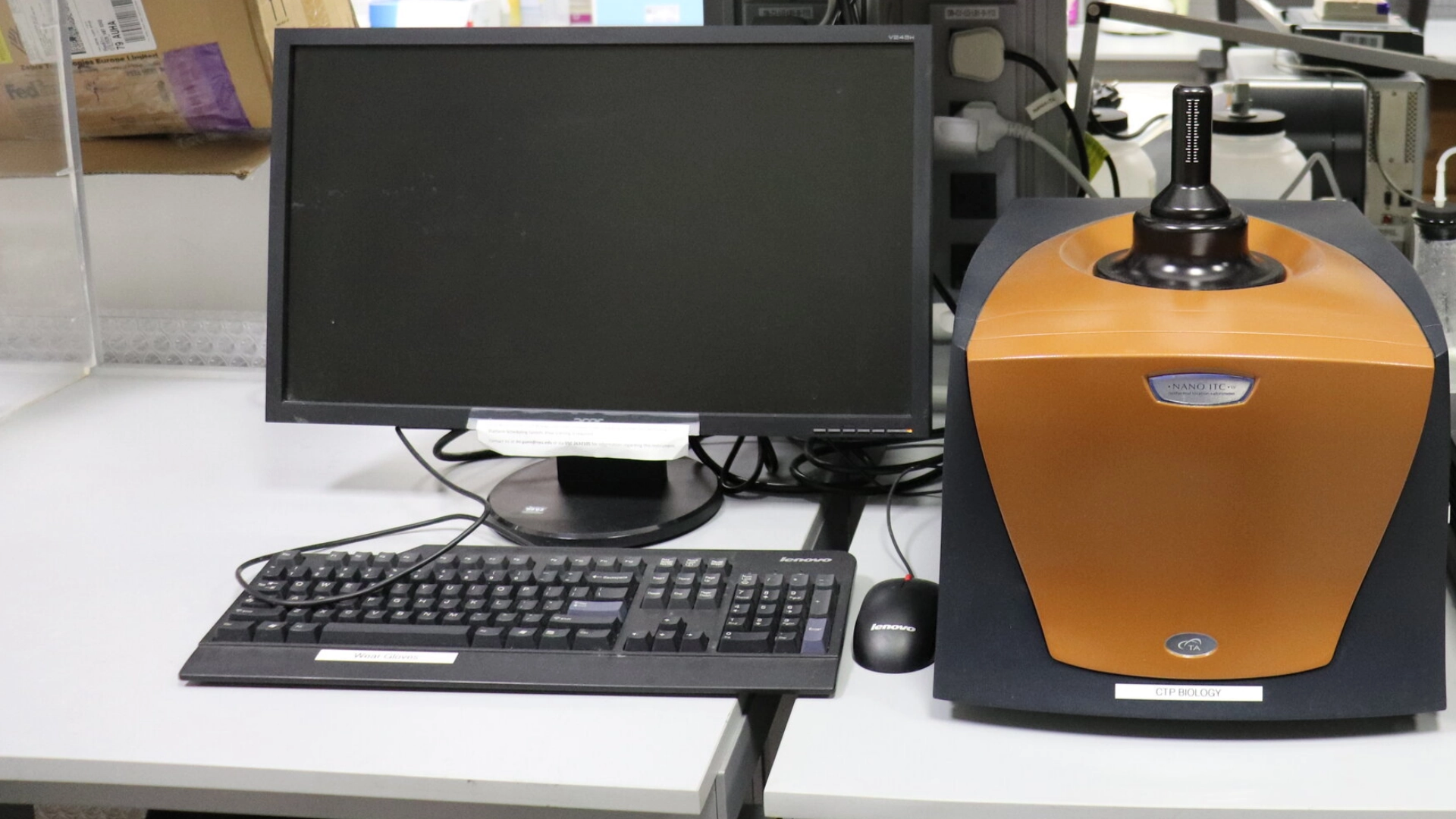Calorimetry
Exploring Heat Measurements for Molecular Interactions and Thermodynamic Properties
Differential Scanning Calorimetry (DSC)

The Nano-DSC (Differential Scanning Calorimeter) is a highly sensitive thermal analysis instrument designed for measuring small thermal events such as heat capacity, phase transitions, and stability of small sample sizes (usually in the microliter or milligram range). This type of calorimeter is particularly useful for studying biological samples, polymers, and materials that require high-resolution thermal data with minimal sample volume.
Key Features
High Sensitivity and Resolution:
- The Nano-DSC offers excellent sensitivity for detecting small heat changes, making it ideal for studying subtle thermal transitions in biological and complex systems. This is critical for samples that undergo low-enthalpy transitions or for small samples.
Small Sample Volume:
- Unlike conventional DSCs that require larger sample quantities, the Nano-DSC is capable of analyzing very small sample sizes, typically in the microliter range, which is ideal for precious or limited samples.
Temperature Range:
- It typically covers a wide temperature range (e.g., from -10°C to 150°C or higher), allowing researchers to study a variety of materials, including biological molecules, polymers, and small organic compounds.
Precise Measurement of Heat Flow:
- Nano-DSCs are designed to measure the heat flow with high precision, making them ideal for capturing even minor thermal changes, which is essential for detecting phase transitions such as denaturation, folding, crystallization, and melting.
Software Control and Analysis:
- The device is often integrated with advanced software that allows for real-time data acquisition, analysis, and reporting. This software can provide thermal profiles, phase transition data, and enthalpy changes.
Isothermal and Scanning Modes:
- The Nano-DSC can operate in both isothermal (constant temperature) and scanning modes, offering versatility for a variety of experiments. The scanning mode is typically used for studying transitions over a range of temperatures.
Non-destructive Testing:
- Nano-DSCs are non-destructive, meaning the sample can be analyzed multiple times without significant degradation, which is particularly beneficial when working with expensive or limited samples.
Minimal Sample Preparation:
- Sample preparation requirements are typically minimal, and the device allows for both aqueous and organic solvents to be studied, making it versatile for various types of chemical and biological analyses.
Applications
Biopharmaceutical and Biotechnology:
- Protein Folding and Stability: Nano-DSCs are widely used in the study of protein folding, denaturation, and stability. These properties are crucial for the development of biopharmaceuticals, ensuring that proteins or enzymes remain stable under various storage and processing conditions.
- Vaccine Development: It is employed in the study of vaccines to analyze the stability and behavior of antigens, adjuvants, and other components under different conditions.
- Biomolecular Interactions: Can be used to study ligand-binding interactions, protein-protein interactions, and other thermodynamic properties related to biopharmaceutical research.
Polymer Science:
- Glass Transition and Melting Points: In polymer science, the Nano-DSC is used to measure glass transition temperatures (Tg), melting points, crystallization, and other thermal properties of polymers and copolymers.
- Polymer Blends and Additives: Researchers use the device to study the compatibility and behavior of polymer blends, including the effects of additives and plasticizers on material properties.
Materials Science:
- Phase Transitions in Materials: The Nano-DSC is useful for studying the thermal transitions in various materials, including ceramics, metals, and composites. This includes understanding how materials respond to temperature changes, which is critical for material design and processing.
- Thermal Stability: It can be used to investigate the thermal stability of materials under different environmental conditions, which is important in applications like aerospace, electronics, and coatings.
Food and Cosmetics Industries:
- Texture and Stability of Food Products: In food science, Nano-DSC can be used to measure the melting and crystallization behavior of fats, emulsions, and other ingredients, which is essential for product formulation and quality control.
- Cosmetic Formulations: For cosmetics, the device is used to analyze the thermal properties of formulations, which can affect the stability and performance of creams, lotions, and other products.
Polymers and Small Molecules:
- The Nano-DSC can analyze the thermal behavior of small organic molecules, such as those used in drug development or in materials design, for understanding phase behavior, crystallization, and degradation.
Environmental Science:
- Degradation Studies: Can be employed to monitor the thermal stability and degradation of environmental materials, such as biodegradable plastics or pollutants, under varying conditions.
Isothermal Titration Calorimetry (ITC)

The Nano-ITC (Isothermal Titration Calorimeter) is a highly sensitive analytical instrument designed to measure the heat changes that occur during biochemical or chemical interactions. It is specifically optimized for small sample sizes and low concentrations, making it ideal for characterizing molecular interactions in a wide variety of fields such as biochemistry, pharmaceutical research, and materials science.
Key Features
Small Sample Volume:
- The Nano-ITC is designed to work with small sample volumes, typically in the microliter range. This makes it particularly useful for applications where sample availability is limited or precious, such as protein-ligand binding studies.
High Sensitivity:
- It has a high degree of sensitivity to detect very small amounts of heat generated or absorbed during molecular interactions, allowing precise measurements even for weak binding events.
Low Detection Limit:
- The instrument can detect minute heat changes in the nanojoule range, which is ideal for studying weak interactions and small biomolecules.
Real-Time Data Acquisition:
- The Nano-ITC provides real-time calorimetric data that directly reflects the thermodynamic properties of the interaction, including enthalpy (ΔH), entropy (ΔS), and binding constants (Kd).
Minimal Sample Requirements:
- It requires as little as 10–20 µL of sample in the reaction cell, and similarly small amounts in the syringe, making it ideal for experiments involving scarce or expensive samples.
Fully Automated Titration:
- The device automates the titration process by injecting small aliquots of titrant into the sample and continuously measuring the heat released or absorbed during each injection.
Advanced Software for Data Analysis:
- The Nano-ITC comes with sophisticated data analysis software that allows users to model and interpret complex interaction data, enabling the extraction of thermodynamic parameters like binding affinity, stoichiometry, and reaction enthalpy.
User-Friendly Interface:
- The system is designed to be easy to operate, with intuitive software interfaces and automated calibration, reducing the learning curve for new users.
Applications
Biomolecular Interactions:
- The Nano-ITC is widely used in biochemistry and molecular biology to study interactions between proteins, nucleic acids, and small molecules (ligands). It is essential for measuring binding constants, stoichiometries, and thermodynamic parameters (ΔH, ΔS, Kd) in protein-ligand, protein-protein, and protein-DNA interactions.
Pharmaceutical Research:
- It is used in drug discovery and development for identifying binding affinities of potential drug candidates, optimizing lead compounds, and studying the thermodynamics of drug-target interactions.
Enzyme Kinetics:
- The instrument can be used to study enzyme-substrate interactions, measuring the heat changes associated with enzyme activity, enzyme inhibition, and cofactor binding.
Antibody-Antigen Interactions:
- Nano-ITC is useful in immunology for characterizing the binding kinetics and thermodynamics of antibodies interacting with antigens.
Small Molecule and Protein Complex Studies:
- It can be applied to the study of small molecule binding to proteins or other macromolecules, providing insight into how small molecules affect protein structure and function.
Nanomaterials and Surface Interactions:
- Beyond biomolecular interactions, Nano-ITC can also be used in materials science to study the thermodynamics of nanoparticle interactions or surface binding phenomena.
Ligand Binding and Thermodynamic Profiling:
- Researchers can use Nano-ITC for conducting in-depth thermodynamic profiling of ligand binding, including the heat capacity changes and changes in entropy associated with molecular interactions.
Polymer Science:
- Nano-ITC is used in polymer chemistry to understand the thermodynamics of polymerization, polymer-ligand interactions, and other related processes.
Real-Time PCR

The Mx3005P is a real-time quantitative polymerase chain reaction (qPCR) system. It is part of Agilent’s line of qPCR instruments, providing researchers with the ability to measure and quantify nucleic acids (DNA/RNA) in real time, typically for gene expression analysis, genotyping, and other molecular biology applications.
Key Features
High Sensitivity and Accuracy:
- The Mx3005P offers high sensitivity in detecting low levels of nucleic acids, making it suitable for a wide range of applications, from gene expression analysis to small-scale quantification of DNA or RNA.
Multiplexing Capability:
- It can perform multiplex qPCR experiments, allowing for the simultaneous detection of multiple targets in a single reaction. This reduces sample consumption and increases throughput.
Fast Cycling Times:
- The system supports rapid qPCR cycling times, which improves the efficiency of experiments, particularly in high-throughput environments.
Broad Dynamic Range:
- The Mx3005P can detect a wide range of target concentrations, providing highly accurate quantification even at low or high target levels.
Advanced Optical System:
- The system is equipped with a spectral filter-based detection system, which ensures accurate and precise fluorescent signal measurement for different dyes and probes.
5-Color Detection:
- It supports up to 5 different fluorescent dyes for multiplex assays, offering versatility in assays requiring multiple targets.
Software Integration:
- The system comes with the Agilent MX Pro QPCR software, which offers easy-to-use data analysis tools, including real-time PCR amplification curves, quantification, and melting curve analysis.
- The software includes built-in analysis algorithms for gene expression analysis, comparative CT analysis, and more.
Touchscreen Interface:
- The Mx3005P features a user-friendly touchscreen interface for easy operation, reducing the need for complex training.
High Throughput:
- It supports a wide variety of sample formats, including 96-well and 384-well plates, enabling high-throughput analysis.
Thermal Block Uniformity:
- The system offers excellent thermal block uniformity, ensuring consistent and reproducible results across all wells.
Data Export Options:
- Results can be easily exported in various formats (e.g., Excel, CSV, PDF), making it convenient to share data and integrate it into other workflows.
Applications
Gene Expression Analysis:
- One of the most common applications of the Mx3005P is measuring the expression levels of specific genes. qPCR allows for the quantification of RNA levels, providing insight into the activity of genes in different biological conditions or treatments.
Gene Copy Number Analysis:
- The Mx3005P can be used to measure the number of gene copies, providing important information for studies related to genetic variation, mutations, and disease states.
SNP Genotyping:
- The system is capable of detecting and quantifying single nucleotide polymorphisms (SNPs), which are variations in the DNA sequence that may contribute to diseases or other phenotypic traits.
MicroRNA Analysis:
- It can be used to quantify microRNA (miRNA) expression, which is critical in regulating gene expression at the post-transcriptional level and plays a role in many diseases.
Pathogen Detection:
- The Mx3005P is used in the detection and quantification of pathogens in clinical diagnostics, food safety, and environmental monitoring, enabling rapid and accurate detection of viral, bacterial, and fungal DNA/RNA.
Quantification of Viral Load:
- It is used in virology to measure the quantity of viral RNA or DNA in clinical samples, which is important for monitoring the progression of viral infections (e.g., HIV, Hepatitis, or SARS-CoV-2).
Toxicology and Pharmacology:
- The system is used to measure the effects of drugs or toxins on gene expression, helping in drug development and toxicology studies.
Epigenetics:
- The Mx3005P can be used for studying epigenetic modifications such as DNA methylation or histone modifications, which influence gene expression without changing the underlying DNA sequence.
Cancer Research:
- qPCR is often applied in cancer research for gene expression profiling, detection of mutations, and quantification of specific cancer biomarkers.
Agrigenomics:
- In agricultural biotechnology, the system is used for gene expression studies, marker-assisted selection, and plant or animal genetic modification.
